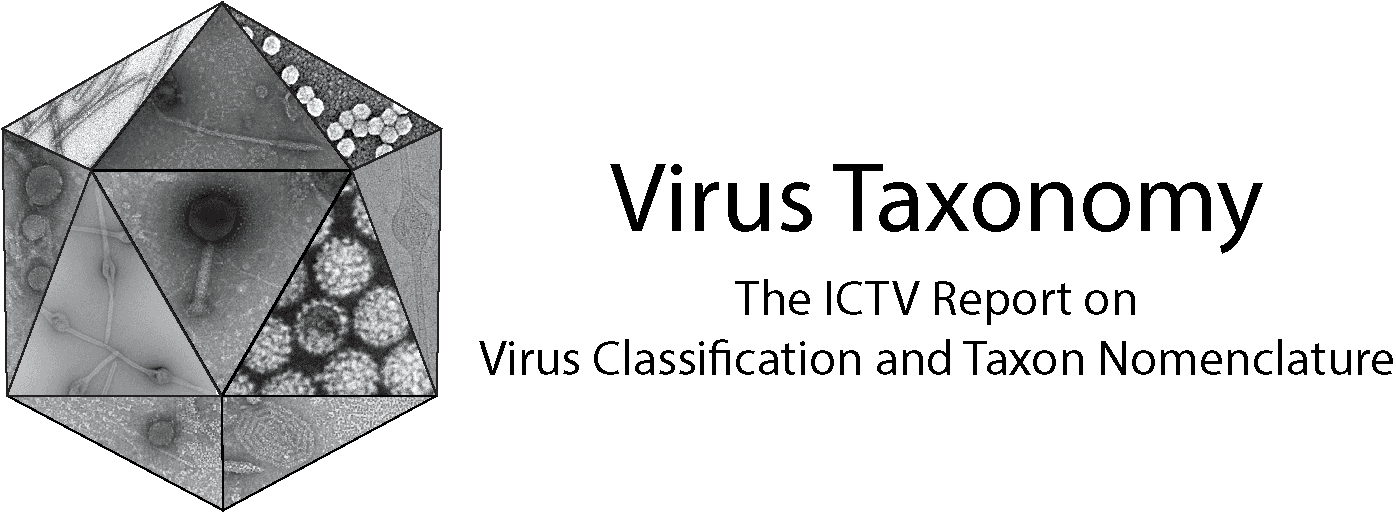Family: Adenoviridae
Genus: Siadenovirus
Distinguishing features
Siadenoviruses are serologically and phylogenetically distinct from members of the other adenovirus genera (Davison et al., 2000, Harrach et al., 2019). They have been identified in frog (Davison et al., 2000), birds (Zsivanovits et al., 2006, Wellehan et al., 2009, Kovács et al., 2010, Kovács and Benkő 2011, Joseph et al., 2014, Ballmann and Harrach 2016, Cassmann et al., 2019, Gottdenker et al., 2019, Sutherland et al., 2019, Yang et al., 2019, Gellért et al., 2022, Surphlis et al., 2022) and turtles (Rivera et al., 2009, Schumacher et al., 2012, Tóth et al., 2024, Bartlett et al., 2025). The completely sequenced siadenoviruses have the shortest adenovirus genomes known to date. The genomic organization of siadenoviruses is also characteristic of the genus and different from that of other genera: the V and IX genes and homologues of the genes in mastadenovirus early regions E1, E3 and E4 are absent, and most siadenoviruses encode a sialidase that is not encoded by other adenoviruses (Davison et al., 2000, Kovács and Benkő 2011).
Virion
Morphology
The 3D fiber structures of turkey adenovirus 3 (TAdV-3; turkey haemorrhagic virus) and raptor adenovirus 1 (RAdV-1) have been established (Singh et al., 2015, Nguyen et al., 2016).
Physicochemical and physical properties
See discussion under family properties.
Nucleic acid
Turkey adenovirus 3 (TAdV-3) was the first siadenovirus to be sequenced, from viral DNA extracted from the spleen of experimentally infected turkeys (Pitcovski et al., 1998). Frog adenovirus 1 (FrAdV-1) was the first siadenovirus to be sequenced from an isolated virus and the only amphibian adenovirus to have been sequenced to date (Davison et al., 2000). The raptor adenovirus 1 (RAdV-1) genome was fully sequenced using PCR amplification from tissue from an infected Harris’s hawk without virus isolation (Kovács and Benkő 2011). Recently, psittacine siadenoviruses have been sequenced and classified into species: psittacine adenovirus 2 (Athukorala et al., 2021, Surphlis et al., 2022) (Siadenovirus cinerei(Athukorala et al., 2021), psittacine adenovirus 5 (PsAdV-5) and psittacine adenovirus 6 (Gottdenker et al., 2019) (and GenBank Accession MK695679) (both Siadenovirus viridis) and psittacine adenovirus 7 (Sutherland et al., 2019) (Siadenovirus sanguineae). The siadenovirus genomes are the shortest adenovirus genomes known to date. The genomes with seemingly correctly sequenced genome ends are between 24,630 (gentoo penguin adenovirus 4) and 27,209 bp (PsAdV-7) (Lee et al., 2016, Sutherland et al., 2019) and have nucleotide compositions of 34.2% G+C (South Polar skua adenovirus 1) to 38.5% (RAdV-1), and inverted terminal repeats (ITRs) of 26 (PsAdV-5) to 39 bp (TAdV-3) (Pitcovski et al., 1998).
Proteins
See discussion under family properties.
Lipids
None reported.
Carbohydrates
See discussion under family properties.
Genome organization and replication
The genomic organization of siadenoviruses is characteristic of the genus and different from that of other genera (Figure 2 Adenoviridae). The V and IX genes and homologues of the genes in mastadenovirus early regions E1, E3 and E4 are absent. Usually, there are only five ORFs potentially encoding novel proteins not found in members of other genera (Park et al., 2012). At the left end of the genome, the first putative gene encodes a protein that is related to sialidases (Davison et al., 2000). This gene is present in all siadenoviruses sequenced to date except the penguin siadenoviruses (Lee et al., 2016). However, the function of this protein is unknown. Adjacent to this gene is a novel ORF predicted to encode a highly hydrophobic protein (accordingly named “hydrophobic protein”) or another novel gene (ORF4) or both (overlapping). Gene E3 is named solely because of its position between the pVIII and fiber genes, but it is not homologous to any of the mastadenovirus E3 genes (or to any other known genes). The right end of the genome harbours ORF7 and ORF8 in all characterized siadenoviruses, and even one or two further genes (“hypothetical protein A” or ORF9, and “hypothetical protein B” or ORF10) in some psittacine adenoviruses, e.g. PsAdV-2 (Siadenovirus cinerei) (Athukorala et al., 2021, Surphlis et al., 2022) or pigeon adenovirus 4 (Łukaszuk et al., 2025).
Most siadenoviruses have not been isolated and propagated. TAdV-3 can be propagated on transformed cell lines (MDTC-RP19 lymphoblastoid turkey cell line established from tumours induced by Marek’s disease virus (family Orthoherpesviridae) in turkeys), and the gene expression profile of TAdV-3 has been analysed (Aboezz et al., 2019). FrAdV-1 can be propagated on the epithelial cell line TH-1 derived from box turtle (Terrapene carolina) heart cells. A “Sulawesi tortoise adenovirus 1” was isolated and propagated on a continuous kidney cell line established from Chinese soft-shelled turtle (Pelosdiscus sinensis) (Tian et al., 2025). TAdV-3 uses sialic acid on N-linked glycoproteins as a cellular receptor (Mahsoub et al., 2020). Recently, the splice map of TAdV-3 has been established by RNA sequencing (Quaye et al., 2024).
Biology
The genus comprises 11 species, most of which include several strains, but a growing number of novel and partially characterized AdVs also apparently belong to the genus. Members of current species include FrAdV-1 and viruses detected in or isolated from birds: TAdV-3, RAdV-1, South Polar skua adenovirus 1, great tit adenovirus 1, chinstrap penguin adenovirus 2 and gentoo penguin adenovirus 4, and numerous psittacine siadenoviruses. FrAdV-1 was isolated from a northern leopard frog (on the TH-1 cell line), and TAdV-3 has been isolated from various galliformes (turkey, pheasant and chicken). RAdV-1 was detected by PCR in deceased captive raptors (Indian eagle-owl, Werreaux’s eagle-owl also known as the milky eagle owl, and Harris’s hawk). FrAdV-1 is not known to be pathogenic in frogs or any other animal. TAdV-3 is associated with specific diseases in various hosts (haemorrhagic enteritis in turkeys, marble spleen disease in pheasants and splenomegaly in chickens) (Palya et al., 2007). PsAdV-2 seems to have an elevated pathogenicity and was found in a large number of various psittacine species: plum headed parakeet, umbrella cockatoo, orange-bellied parrot, African grey parrot, Alexandrine parakeet, budgerigar, cockatiel, eastern rosella, red-crowned parakeet, scarlet-chested parakeet, etc. (Ballmann and Vidovszky 2013, Phalen et al., 2019, Yang et al., 2019, Surphlis et al., 2022, Zadravec et al., 2022). PsAdV-5 was described from Pacific parrotlet, sun parakeet, cockatiel and budgerigar and rosy-faced lovebird (Gottdenker et al., 2019) (and GenBank Accession MK695679 and OR871656). The siadenovirus found in various tortoises, first in Sulawesi tortoise and thus named Sulawesi tortoise adenovirus 1, proved to be able to cross species barriers by infecting and killing different (captive) turtle species (Rivera et al., 2009, Schumacher et al., 2012, Vincent et al., 2023). Recently its complete genome has been sequenced from an isolate from farmed Chinese soft-shelled turtle when it caused disease outbreaks with a mortality rate higher than 60% in a breading farm (Tian et al., 2025). The signs were decreased egg laying, slight epithelial haemorrhage on the plastron, and severely haemorrhagic intestine with undigested beige residual (Tian et al., 2025).
Antigenicity
TAdV-3 has no common complement-fixing antigen with avi- or barthadenoviruses.
Species demarcation criteria
Species designation depends on at least two of the following characteristics:
- Phylogenetic distance (>10–15%, based on maximum likelihood analysis of the pol amino acid sequence)
- Host range
- Nucleotide composition
- Genome organization
Related, unclassified viruses
| Virus name | Accession number | Abbreviation |
| bar-headed goose adenovirus | PP331827 | |
| black-headed gull adenovirus | PP331832 | |
| black noddy (Charadriiformes) adenovirus | OL436124 | |
| black-winged stilt (Charadriiformes) adenovirus | PP331831 | |
| bog turtle adenovirus 4 | PP938075 | |
| Bourke’s parrot adenovirus | PP665677 | |
| brown booby (Suliformes) adenovirus | OL436128 | |
| brown noddy (Charadriiformes) adenovirus | OL436127 | |
| double-barred finch adenovirus | MN380550 | |
| Eurasian blackbird adenovirus | ON304002 | |
| Eurasian blackcap adenovirus 1 | MN380556 | |
| Eurasian curlew adenovirus | PP319136 | |
| great cormorant adenovirus 2 | PP319074 | |
| greater white-fronted goose adenovirus | PP331829 | |
| Gouldian finch adenovirus 1 | KF031569 | GFAdV-1 |
| long-tailed finch adenovirus | MK413652 | |
| pigeon adenovirus 4 (proposed) | PP329621 | PiAdV-4 |
| pigeon adenovirus 5 | KX555532 | PiAdV-5 |
| quail adenovirus 1 (proposed) | PV175342 | |
| rainbow lorikeet adenovirus | MT457859 | |
| red-rumped parrot adenovirus | PP665675 | |
| spotted pardalote adenovirus | MN238653 | |
| sooty tern (Charadriiformes) adenovirus | OL436132 | |
| Sulawesi tortoise adenovirus 1 (Chinese soft-shelled turtle adenovirus) (proposed) | PQ083072 | STAdV-1 |
| superb fairywren adenovirus | MN238654 | |
| taiga bean goose adenovirus | PP319155 | |
| yellow cardinal adenovirus | MN602948 | |
| zebra finch adenovirus strain 47535 | MN380549 |
Virus names and virus abbreviations are not official ICTV designations.
“Proposed” indicates that the virus type has been proposed to the ICTV in 2025 as founding a new species (e.g. quail adenovirus 1 “Siadenovirus coturnicis”). Many avian siadenoviruses have been detected only by partial sequencing, e.g. from psittacines: budgerigar, cockatiel (Cassmann et al., 2019), rainbow lorikeet (Chang et al., 2020), Bourke’s parrot and red-rumped parrot (Lizzi et al., 2024). The phylogenetic relationships of these siadenoviruses, especially when partial sequences are available from different genes, remain to be established firmly, but several of these viruses may belong to the same species. Additional avian siadenoviruses have been detected in passerines (perching birds or songbirds, Passeriformes): Gouldian finch (Joseph et al., 2014), long-tailed finch (Phalen et al., 2019) (the same virus also in zebra finch and double-barred finch), Eurasian blackcap (Rinder et al., 2020), racing and fancy pigeons (Columbiformes) (Ballmann and Harrach 2016) and Eurasian blackbird (French et al., 2022). Novel siadenoviruses have also been detected by PCR in turtles: in Chinese pond turtle (Tóth et al., 2024) and bog turtle (Bartlett et al., 2025).

